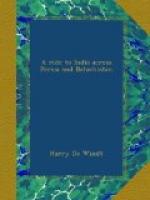[Illustration: OUR CAMP AT OUTHAL]
Daybreak saw us well en route and by 10 a.m. we were in sight of Beila. About a mile or so out of the city, a mounted sowar in scarlet and gold uniform, and armed with two huge horse-pistols and a long cavalry sabre, galloped up to the caravan. “It is a messenger from the palace,” said Kamoo, “to say that his Highness the Djam has been suddenly called away to Kej, [C] but that his son, Prince Kumal Khan, is riding out in state to meet the sahib, and conduct him to his father’s city.”
The prince shortly afterwards appeared, mounted on a huge camel, the tail and hind quarters of which were ornamented with intricate patterns stamped on the hide by some peculiar process. A guard of honour of thirty soldiers accompanied, while a rabble of two or three hundred foot people surrounded the party, for the sight of a white face is rare in Beila. It was a strange scene: the picturesque city, brilliant barbaric costume of the young chief and his followers, and crowd of wild, half-naked Baluchis were fitly set off by surroundings of desert landscape and dazzling sunshine. A Gerome or Vereschagin would have revelled in the sight.
Shaking hands with Kumal (no easy matter on camels), he placed me on his right hand, and, heading the procession, we rode into Beila, where a large tent had been erected for my accommodation. Having placed a guard at my disposal, the prince then left, announcing his intention of receiving me in state that afternoon at the palace.
Beila, which is protected by a fort and high mud wall, is situated on the right bank of the river Purali, which, at the time of my visit, was no more than a dry rocky bed. The town contains about 4000 inhabitants, and, from a distance, presents a curious appearance, each house being fitted, as at Sonmiani, with a large “badgir,” or wind-catcher. Like most Eastern cities, Beila does not improve on closer acquaintance. The people are dirty and indolent. There is little or no trade, and the dark, narrow streets, ankle-deep in mud and filth, are crowded with beggars and pariah dogs, while the dull drab colour of the mud houses is depressing in the extreme. The fort and palace alone are built of brick, and, being whitewashed, relieve to a certain extent the melancholy aspect of the place. I was escorted to the latter the afternoon of my arrival by a guard of honour, preceded by the Djam’s band—half a dozen cracked English cavalry trumpets!
Djam Ali Khan, the present ruler of the state of Las Beila, is about fifty years of age, and is a firm ally of England. The Djam is a vassal of the Khan of Kelat, but, like most independent Baluch chiefs, only nominally so. So far as I could glean, the court of Kelat has no influence whatsoever beyond a radius of twenty miles or so from that city. The provinces of Sarawan, Jhalawan, Kach-Gandava, Mekran, [D] and Las Beila, which constitute the vast tract of country known as Kalati Baluchistan, are all governed by independent chiefs, nominally viceroys of the Khan of Kelat. Practically, however, the latter has little or no supremacy over them, nor indeed over any part of Baluchistan, Kelat and its suburbs excepted.




